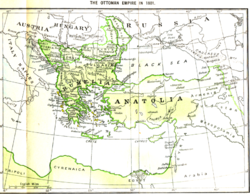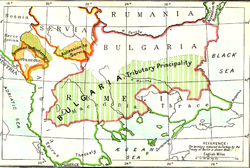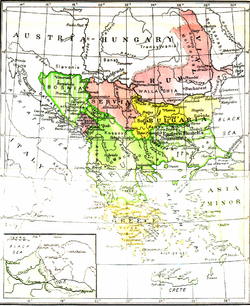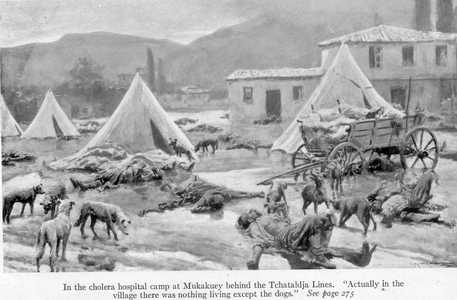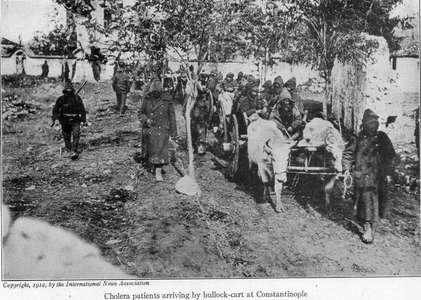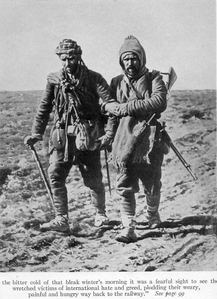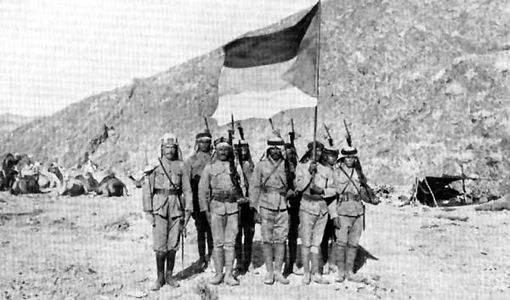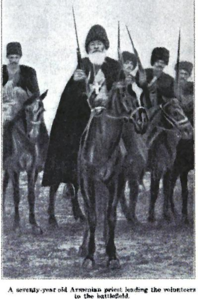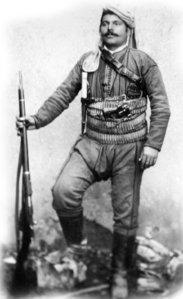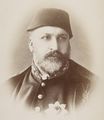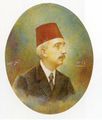انحلال الدولة العثمانية
| جزء من سلسلة عن |
| تاريخ الدولة العثمانية |
|---|
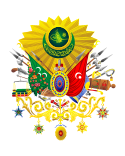 |
| البزوغ (1299–1453) |
| ما بين السلاطين (1402–1413) |
| النمو (1453–1606) |
| الركود (1606–1699) |
| سلطنة الحريم |
| فترة كوپريلي (1656–1703) |
| الاضمحلال (1699–1792) |
| فترة التيوليپ (1718–1730) |
| الانحلال (1792–1923) |
| فترة التنظيمات (1839–1876) |
| فترة المشروطية الأولى |
| فترة المشروطية الثانية |
| التقسيم |
|
|
انحلال الدولة العثمانية (9 يناير 1792 – 24 يوليو 1923)، هي الفترة التي تلت اضمحلال الدولة العثمانية والتي أثنائها بدأت الجماعات العرقية المختلفة في الثورة، ووقعت خلالها معاهدة ياسي ومعاهدة لوزان. تلك الثورات بالإضافة إلى الحروب الأربعة التي شنتها الدولة العثمانية ضد روسيا والمشكلات الاقتصادية الخطيرة، تسببت جميعها في انحلال عام للدولة العثمانية. اصلاحات تحديث الدولة لم تكن كافية للحاق بالعالم الغربي. قاتلت الدولة العثمانية ضد الحلفاء في الحرب العالمية الأولى وفي نهاية الحرب كان الحلفاء قد قسموها، مما أدى إلى قيام حرب الاستقلال التركية. عام 1923، حلت محل الامبراطورية العثمانية القديمة من القرن السادس، جمهورية تركيا الحديثة.
مصطفى الرابع (1807–1808)
بعد تمرد كباكچي مصطفى، أطيح بالسلطان الاصلاحي سليم الثالث عن الحكم عام 1807. السلطان الجديد، مصطفى الرابع، كان معارض لجميع المشروعات الاصلاحية. غير أن فترة حكم السلطان مصطفى الرابع كانت قصيرة. أطاح به الاصلاحي علمدار مصطفى پاشا الموالي للسلطان سليم الثالث. إلا أن سليم الثالث قتل على يد مصطفى الرابع وتولى محمد الثاني الحكم.
محمود الثاني (1808–1839)
بعد تولي محمود الثاني الحكم، كان عليه التعامل مع العديد من المشكلات والتي كان قد ورثها عن الأجيال السابقة. منها المسألة الشرقية مع روسيا، إنگلترة، وفرنسا، والمشكلات العسكرية التي سببها ثورات الإنكشارية وعلماء الدين المنشقين. كما واجه أيضاً عدة نزاعات داخلية مع المصريين، الوهابيين، الصرب، الألبان، اليونانيين والسورييي، بالإضافة إلى مشكلات ادارية بسبب تمرد الباشاوات، ممن يسرهم تأسيس ممالك جديدة على أطلال آل عثمان.
الادارة
عمل السلطان محمود الثاني على تطوير دولته؛ ولذلك قنن قوانين حتى يستطيع أن ينظم شؤون الإدارة المحلية في دولته، وكانت تلك القوانين مستمدة من الشرع الحكيم.
وشكل السلطان محمود لجنة من خيار العلماء لتشرف على وضع (قانون نامه) المستمد من الشريعة الغراء وجعله أساساً لحكم دولته، وكان هذا القانون مكوناً من ثلاثة أبواب، يتعلق بمناصب الموظفين وببعض التقاليد وما يجب أن يتخذ من التشريفات والاحتفالات السلطانية وهو يقرر كذلك العقوبات والغرامات، ونص صراحة على جعل الدولة حكومة إسلامية قائمة على تفوق العنصر الإسلامي أياً كان أصله وجنسه. واهتم محمد الفاتح بوضع القوانين التي تنظم علاقة السكان من غير المسلمين بالدولة ومع جيرانهم من المسلمين ومع الدولة التي تحكمهم وترعاهم، وأشاع العدل بين رعيته، وجد في ملاحقة اللصوص وقطاع الطرق، وأجرى عليهم أحكام الإسلام ، فاستتب الأمن وسادت الطمأنينة في ربوع الدولة العثمانية.
وعندما تعلن الدولة الجهاد وتدعوا أمراء الولايات وأمراء الألوية، كان عليهم أن يلبوا الدعوة ويشتركوا في الحرب بفرسان يجهزونهم تجهيزاً تاماً، وذلك حسب نسب مبينة، فكانوا يجهزون فارساً كامل السلاح قادراً على القتال عن كل خمسة آلاف آقجه من إيراد اقطاعه ، فإذا كان إيراد إقطاعه خمسمائة ألف آقجة مثلاً كان عليه أن يشترك بمائة فارس، وكان جنود الإيالات مؤلفة من مشاة وفرسان، وكان المشاة تحت قيادة وإدارة باشوات الإيالات وبكوات الألوية. وقام محمد الفاتح بحركة تطهير واسعة لكل الموظفين القدماء غير الأكفاء وجعل مكانهم الأكفاء، واتخذ الكفاية وحدها أساساً في اختيار رجاله ومعاونيه وولاته.
الاقتصاد
اهتم السلطان محمد الفاتح بالتجارة والصناعة وعمل على إنعاشهما بجميع الوسائل والعوامل والأسباب. وكان العثمانيون على دراية واسعة بالأسواق العالمية، وبالطرق البحرية والبرية وطوروا الطرق القديمة، وأنشأوا الكباري الجديدة مما سهل حركة التجارة في جميع أجزاء الدولة، واضطرت الدول الأجنبية من الاستيلاء على موانيها لرعايا الدولة العثمانية ليمارسوا حرفة التجارة في ظل الراية العثمانية. وكان من أثر السياسة العامة للدولة في مجال التجارة والصناعة أن عم الرخاء وساد اليسر والرفاهية في جميع أرجاء الدولة، وأصبحت للدولة عملتها الذهبية المتميزة، ولم تهمل ا لدولة إنشاء دور الصناعة ومصانع الذخيرة والأسلحة، وأقامت القلاع والحصون في المواقع ذات الأهمية العسكرية في البلاد.
العسكرية
تميز عصر السلطان محمود الفاتح بجانب قوة الجيش البشرية وتفوقه العددي، بإنشاءات عسكرية عديدة متنوعة، فأقام دور الصناعة العسكرية لسد احتياجات الجيش من الملابس والسروج والدروع ومصانع الذخيرة والأسلحة، وأقام القلاع والحصون في المواقع ذات الأهمية العسكرية ، وكانت هناك تشكيلات متنوعة في تمام الدقة وحسن التنظيم من فرسان ومشاة ومدفعية وفرق مساعدة، تمد القوات المحاربة بما تحتاجه من وقود وغذاء وعلف للحيوان وإعداد صناديق الذخيرة حتى ميدان القتال. وكان هناك صنف من الجنود يسمى، "لغمجية" وظيفته الحفر للألغام وحفر الأنفاق تحت الأرض أثناء محاصرة القلعة المراد الاستيلاء عليها وكذلك السقاؤون كان عليهم تزويد الجنود بالماء. ولقد تطورت الجامعة العسكرية في زمن الفاتح وأصبحت تخرج الدفعات المتتالية من المهندسين والأطباء والبيطريين وعلماء الطبيعيات والمساحات ، وكانت تمد الجيش بالفنيين المختصصين. استحق معه أن يعده المؤرخون مؤسس الأسطول البحري العثماني ، ولقد استفاد من الدول التي وصلت إلى مستوى رفيع في صناعة الأساطيل مثل الجمهوريات الإيطالية وبخاصة البندقية وجنوا أكبر الدول البحرية في ذلك الوقت.
المجتمع
حفز انتشار المفهوم الغربي للقومية على نهوض القوميات تحت الحكم العثماني وفي النهاية أدى إلى انهيار المفهوم الملي العثماني. مما لا شك فيه، فقد كان مفهوم الأمة السائد في الدولة العثمانية مختلف عن المفهوم الحالي والذي يتركز على الدين.
عبد الحميد الأول (1839–1861)
عام 1839 بدأ حاتي الشريف فترة التنظيمات (الاصلاح واعادة التنظيم). قبل صدور الفرمان الأول، كان أملاك الأشخاص المنفيين أو المحكوم عليهم بالإعدام تنتقل إلى السلطان، which kept a sordid motive for acts of cruelty in perpetual operation, besides encouraging a host of vile Delators. بموجب الفرمان الثاني، سقطت الحقوق القديمة للحكام الأتراك باعدام الرجال بالإرادة الشخصية؛ الباشوات، الأغاوات، والضباط الآخرون "لا يفترض أن يحكموا بالاعدام على أي رجل، سواء كان من الرعايا أو من الأتراك، إلا بعقوبة قضائية معلنة من القاضي، وتحمل توقيعه".
حرب القرم 1853–1856
حرب القرم كانت بين الامبراطورية العثمانية من جانب وتحالف يضم فرنسا، المملكة المتحدة، مملكة سردينيا (التي ستدمج في إيطاليا عام 1861)، والدولة العثمانية من جانب آخر. كانت الحرب جزء من المنافسة الطويلة بين القوى الاوروپية العظمى من أجل فرض نفوذها على أراضي الدولة العثمانية المتراجعة. معظم النزاع وقع في ِشبه جزيرة القرم، بالإضافة إلى مواجهات أخرى وقعت في غرب تركيا ومنطقة البحر الأسود.
عبد العزيز (1861–1876)
(الولايات) قد أعلنت عام 1864 وتأسس مجلس الدولة عام 1868. تبنى التعليم الحكومي النموذج الفرنسي وأعيد تنظيم جامعة إسطنبول كمؤسسة معاصرة عام 1861. كذلك كان عبد العزيز أول سلطان عثماني يسافر للخارج. شملت رحلته عام 1867 زيارة إلى المملكة المتحدة.
بلغاريا، عقد 1870
أدى نهوض الصحوة القومية في بلغاريا إلى ظهور حركة الاحياء البلغاري. على عكس اليونان وصربيا، لم تركز الحركة القومية البلغارية في البداية على المقاومة المسلحة ضد الدولة العثمانية. بعد تأسيس الإكسارخية البلغارية في 28 فبراير 1870 بدأ نضال مسلح على نطاق كبير في بداية عقد 1870، بتأسيس [[المنظمة الثورية الداخلية] واللجنة المركزية الثورية البلغارية، بالإضافة إلى المشاركة النشطة لڤاسيل لڤسكي في المنظمتين. وصل النضال إلى ذروته مع إندلاع انتفاضة أبريل عام 1876 في مختلف الولايات البلغارية في مويسيا، تراقيا ومقدونيا. بتزايد قمع الثورة واقتراف الجنود العثمانيين لأعمال العنف تجاه المدنيين (حوالي 15.000 قتيل من المدنيين)[1] فتزايدت رغبة البلغاريين في الاستقلال.
مراد الخامس (1876)
بعد خلع السلطان عبد العزيز، تولى مراد الخامس الحكم. كان يؤمل أن يوقع السلطان الجديد على الدستور. إلا أنه بسبب المشكلات الصحية التي عانى منها مراد الخامس، خُلع بعد 93 يوم؛ وكانت أقصر فترة حكم لسلطان عثماني.
عبد الحميد الثاني (1876–1909)
فترة المشروطية الأولى 1876–1878
فترة المشروطية الأولى في الدولة العثمانية كانت فترة ملكية دستورية من إصدار القانون الأساسي، والذي كتبه أعضاء العثمانيين الشباب، امتدت من 23 نوفمبر 1976 حتى13 فبراير 1878. انتهت الفترة بتعليق عبد الحميد الثاني للمجلس العمومي.
الحرب الروسية التركية (1877–1878)
ترجع أصول الحرب الروسية التركية 1877–1878 ببزوغ القومية في البلقان وكذلك بالأهداف الروسية في استرداد الأراضي التي خسرتها أثناء حرب القرم، اعادة نفوذها في البحر الأسود وفي أعقاب محاولة الحراك السياسي تحرير دول البلقان من الحكم العثماني. نتيجة لهذه الحرب، حصلت إمارات رومانيا، صربيا، والجبل الأسود، على سيادتها "بحكم الأمر الواقع" لبعض الوقت، وأعلنت رسمياً استقلالها عن الدولة العثمانية. بعد استمرار الهيمنة العثمانية لما يقرب من نصف قرن (1396–1878)،أعيد تأسيس الدولة البلغارية باسم إمارة بلغارية، وكانت تغطي الأراضي الواقعة بين نهر دبلن وجبال البلقان (عدا دوبروديا الشمالية والتي مُنحت لرومانيا) ومنطقة صوفيا، والتي أصبحت عاصمة الدولة الجديدة. كذلك سمح كونگرس برلين للنمسا-المجر باحتلال البوسنة والهرسك وسيطرت بريطانيا العظمى على قبرص، بينما ضمت الامبراطورية الروسية بسارابيا الجنوبية ومنطقة قارص.
فترة المشروطية الثانية، 24 يوليو 1908

في غضون أسابيع قليلة من شهر يوليو 1908 غيرت ثورة تركيا الفتاة البنية السياسية للامبراطورية.
انهار نظام السلطان عبد الحميد الذي استمر لأكثر من 35 عام والنظام الاوتوقراطي السابق الذي تطور في عهده. الأرمن، السوريون الروم الكاثوليك، رومان الأرخبيل، والبلغاريون نسوا الدولة العثمانية وبدأوا عهد جديد من الإخاء والتقدم. كان هناك فكرة وجماعات متحدة والتي كانت تحارب بعضها البعض، ورغبت في العمل للتحرر من العبودية في ظل الدولة العثمانية. زعماء الجماعات المقدونية (المنظمة الثورية المقدونية الداخلية) تآخوا مع أعضاء "جمعية الاتحاد والترقي"؛ تجمع اليونانيين والبلغاريين تحت مظلة ثاني أكبر الأحزاب العثمانية "الاتحاد الليبرالي". رحب الجناح الاتحادي البلغاري بالثورة وانضم فيما بعد للحياة السياسية السائدة باسم حزب الاتحادية الشعبية (القطاع البلغاري). حتى، بعض القادة مثل ساندانسكي وچرنوپيڤ شاركوا في مسيرة بالقسطنطينية[2][3] "لمحاولة حل الدستور". الوسطيون السابقون في المنظمة الثورية المقدونية الداخلية أسسوا النوادي الدستورية البلغارية وشاركوا أيضاً في الانتخابات العثمانية. الأرمن الذين أسسوا حزب أرمنكان، حزب هنچاكيان الديمقراطي الاشتراكي والاتحاد الثوري الأرمني بدأوا العمل بحرية في غياب قمع السلطان عبد الحميد لهم.
السخط على نظام المشروطية
بمجرد ما مرت الثورة بدون حدوث تغير يذكر، أصبح الاستياء من النظام الجديد واضحاً في عام 1909. لم تستمر فكرة الاتحاد طويلاً. افترض النظام السياسي حديث النشأة أن مواطنو الدولة يمكنهم الاتحاد تحت علم واحد يمثل العثمنة. عملية استبدال المسؤسسات الملكية بمؤسسات دستورية وسياسات انتخابية لم تكن لا بسيطة ولا سلمية مثلم تغيير النظام نفسه. استمر الإطار الخارجي للدولة في الانشقاق تحت ضغوط الثورات
بسبب سياسيات السلطان عبد الحميد، كان التوزان بين المسلمين والمسيحيين مستحيلاً. بسبب ضغط النزاعات الدينية والعرقية، كان للحكومة الجديدة قدرة محدودة على حل مشكلات الدولة.
الاتحاد الكريتي مع اليونان 1908
بعد الثورة (1908)، أعلن النواب الكريتيون الاتحاد مع اليونان مستغلين قيام الثورة وكذلك وقت عطلة زايميس وغيابه عن الجزيرة.[4] مر عام 1908 ولم يتم حل القضية بين الدولة العثمانية والكريتيين. عام 1909، بعدما انتخب المجلس العمومي التشكيل الحكومي، قررت جمعية الاتحاد والترقي أنه إذا تمت المحافظة على النظام وإحترام حقوق المسلمين، فسوف تحل القضية من خلال المفاوضات.
الألبان والأبجدية اللاتينية 1909
ألبان تيرانا وإلباسان كانوا ضمن المجموعات الأولى التي اضنمت لحركة المشروطية. إلا أنه، بسبب تغير الحدود القومية في البلقان، فقد أُدمج الألبان كشعب بلا وطن. من أكثر عوامل التي وحدت الألبان، لغتهم المشتركة، افتقارهم لصيغة أدبية قياسية أو حتى أبجدية قياسية. كل خيار من الثلاثة المتاحين، الكتابة اللاتينية، السريالية والعربية، التوجهات السياسية والدينية المختلفة، لاقت معارضة من طرف أو مجموعة أخرى من السكان. في يوليو 1908، بعد شهر من ثورة تركيا الفتاة في مقدوينة والتي دعمتها الانتفاضية الألبانية في كوسوڤو ومقدونيا، وتصاعد العصيان والمترد داخل الجيش العثماني، وافق السلطان عبد الحميد الثاني على مطالب ثورة تركيا الفتاة لاستعادة الحكم الدستوري. شارك معظم الألبان في انتفاضة تركيا الفتاة، آملين في الحصول على الحكم الذاتي لشعوبهم ضمن الدولة العثمانية. من نتائج الثورة رفع الحظر العثماني على مدارسة الألبانية وعلى الكتابة باللغة الألبانية. ونتيجة لذلك، التقى المفكرون الألبان في ماناستير عام 1908 لاختيار الأبجدية اللاتينية ككتابة قياسية لهم.
نادت الحكومة الجديدة أيضاً بالتضامن الإسلامي لكسر وحدة الألبان واستخدمت رجال الدين المسلمين في محاولة لفرض اللغة العربية. رفض الألبان التوقيع على حملة تركيا الفتاة "لعثمنتهم" بالقوة.
محمد الخامس (1909–1918)
محاولة حل الدستور 1909
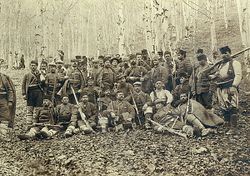
بعد تسعة شهور من تشكيل الحكومة الجديدة، ظهر السخط من خلال حركة أصولية حاولت إنهاء فترة المشروطية الثانية واستعادة الملكية تحت حكم السلطان عبد الحميد. اكتسب الانقلاب المضاد جاذبيته عندما وعد السلطانب بعودة الخلافة، وبالقضاء على السياسات العلمانية، وعودة الشريعة الإسلامية.
كان "حادث 31 مارس" تمرداً على الانقلاب المضاد. في 13 أبريل 1909، خُلع السلطان عبد الحميد الثاني من الحكم، وأصبح محمد الخامس سلطاناً. وقع السلطان محمد الخامس على الدستور في 5 أغسطس 1909، والذي قضى بالمساواة بين الجميع في الضرائب، الخدمة العسكرية (سمح للمسيحيين بالانضمام للعسكرية لأول مرة)، والحقوق السياسية. كان ينظر للدستور الجديد على أنه خطوة كبيرة في طريق تأسيس القانون العام. تم تقليص سلطات السلطان بشكل بكير، إلا أن احتفظ ببعض السلطات الدستورية، مثل إمكانه إعلان الحرب.
الدستور الجديد، كان يهدف إلى منح المزيد من السيادية للعامة، لكنه لم يعالج خدمات عامة محددة، مثل الدين العام العثماني، البنك العثماني وادارة الدين العام لخصائصهم الدولية. ينطبق نفسي الشئ على معظم الشركات التي تشكلت لتنفيذ الأعمال العامة مثل سكك حديد بغداد، تجارة التبغ والسجائر والتي تتولها شركتان فرنسيتان "شركة ريجي" و"شركة نرگيله للتبغ".
الحرب الإيطالية 1911
أعلنت إيطاليا الحرب على الدولة العثمانية في 29 سبتمبر 1911، مطالبة بالاستيلاء على طرابلس وبرقة. كان الرد العثماني ضعيفاً ومن ثم فقد استولت القوات الإيطالية على تلك المناطق في 5 نوفمبر من العام نفسه (تم التصديق على هذا التحرك بقانون أصدره البرلمان الإيطالي في 25 فبراير 1912). على الرغم من ذلك، فقد كانت هذه الحرب نذير ليام الحرب العالمية الأولى كما أثارت النزعة القومية في دول البقان. فبعد أن رأوا كيف تمكن الإيطاليون بسهولة من هزيمة القوات العثمانية الغير منظمة، هاجم أعضاء عصبة البلقان الدولة العثمانية قبل انتهاء الحرب مع إيطاليا.
حروب البلقان 1912–1913

شكلت ثلاث من دول البلقان في نهاية القرن التاسع عشر الجول الأسود، وتطلعت إلى أراضي إضافية من مناطق ألبانيا، مقدنية وتراقيا، خلف مزاعهم القومية. ظهور هذه الدولة الثلاثية الغير متكملة على هامش الدولة العثمانية في القرن التاسع عشر، مهد الطريق لحروب البلقانز في 10 أكتوبر 1912، تم تسليم المذكرة الجماعية للسلطات في القسطنطينية. في 14 أكتوبر، استجابت الدولة العثمانية للمطالب الاوروپية باجراء اصلاحات في مقدونيا[5] But before further action could be taken war broke out. While Powers were asking Empire to reform Macedonia, under the encouragement of Russia, a series of agreements were concluded: between صربيا وبلغاريا in March 1912, between Greece and Bulgaria in May 1912, and Montenegro subsequently concluded agreements between Serbia and Bulgaria respectively in October 1912. الاتفاقية البلغارية-الصربية دعت تحديداً إلى تقسيم مقدونيا وهو ما أسفر عن اندلاع حرب البلقان الأولى. وفي 1913 a nationalist uprising broke out in Albania, and on 8 October, the عصبة البلقان, consisting of Serbia, Montenegro, Greece and Bulgaria, mounted a joint attack on the Ottoman Empire, starting the حرب البلقان الأولى. The strong march of the Bulgarian forces in Thrace pushed the Ottoman armies to the gates of Istanbul. The Second Balkan War soon followed. ألبانيا أعلنت الاستقلال في 28 نوفمبر، ووافقت الدولة العثمانية على وقف اطلاق النار في 2 ديسمبر، وخسائرها الإقليمية أصبحت مُعترف بها في 1913 في معاهدتي لندن وبوخارست. أصبحت ألبانيا مستقلة، وخسرت الدولة العلية تقريباً كل أراضيها الأوروبية (كوسوڤو، سنجق نوڤي پازار، مقدونيا وتراقيا الغربية) لصالح الحلفاء الأربع.
التنازل عن الكويت، 1913
The Anglo-Ottoman Convention of 1913 was a short-lived agreement signed in July 1913 between the Ottoman sultan Mehmed V and the British over several issues. However the status of Kuwait that came to be the only lasting result, as its outcome was formal independence for Kuwait.
During World War I, the Ottoman Empire was financially crippled and the invading British forces invalidated the Anglo-Ottoman Convention, declaring Kuwait to be an "independent sheikdom under British protectorate."
التنازل عن ألبانيا، 1913
Albania had been under Ottoman rule from around 1478. When Serbia, Montenegro, and Greece laid claim to Albanian-populated lands during Balkan Wars, the Albanians declared independence.[6]
The European Great Powers endorsed an independent Albania in 1913, after the Second Balkan War leaving outside the Albanian border more than half of the Albanian population and their lands, that were partitioned between Montenegro,Serbia and Greece. They were assisted by Aubrey Herbert, a British MP who passionately advocated their cause in London. As a result, Herbert was offered the crown of Albania, but was dissuaded by the British prime minister, H. H. Asquith, from accepting. Instead the offer went to William of Wied, a German prince who accepted and became sovereign of the new Principality of Albania.
The young state, however, collapsed within weeks of the outbreak of World War I.[6]
قبل الحرب العالمية الأولى
In early 1914 the Ottoman Government was concerned with three main goals. The first was improving relations with Bulgaria; the second was to encourage support from the Germans, and the third was to settle negotiations with Europe about the Armenian reform.
With regard to the first, the Ottoman Empire and Bulgaria showed sympathy to one another because they suffered as a result of the territories lost with the Balkan Wars (1912–1913). They also had bitter relations with Greece. It was natural and beneficial for them to work for the development of policies that enabled them to gain better positions in the region.
With regard to the second, there were three military missions active at the turn of 1914. These were the British Naval Mission led by Admiral Limpus, the French Gendarme Mission led by General Moujen, and the German Military Mission led by Goltz. The German Military Mission become the most important among these three. The history of German-Ottoman military relations went back to the 1880s. الصدر الأعظم سعيد حليم پاشا ووزير الحربية أحمد عزت پاشا were instrumental in developing the initial relations. القيصر ڤلهلم الثاني ordered Colmar Freiherr von der Goltz to establish the first German mission. General Goltz served two periods within two years. In the early 1914, the Ottoman Minister of War was a former military attaché to Berlin, أنور پاشا. About the same time, General Otto Liman von Sanders, was nominated to the command of the German 1st Army. It was the biggest located in the European side. General Liman von Sanders and Enver Pasha practically shared the commander-in-chief position.
With regard to the third, an Armenian reform package was negotiated with Russia. Russia, the protector of Armenians and acting on behalf of the Great Powers, played a crucial role introducing reforms for the Armenian citizens of the empire. The Armenian reform package, which was solidified in February 1914, was based on the arrangements nominally made in 1878. According to this arrangement the inspectors general, whose powers and duties constituted the key to the question, were to be named for a period of ten years, and their engagement was not to be revocable during that period.
التنازلات والدين العام
حين أُقرت التعهدات لأول مرة، كان المفترض أن المساعدة الأجنبية ستفيد الدولة العثمانية. نصت التعهدات أن المزايا كانت تقوم على أساس الدين. فالحوار بين العالم المسيحي والعالم الإسلامي كان يقوم على أسس مختلفة. فالأجانب قد حصلوا على العديد من المزايا أو "التعهدات" that they could not be brought under local jurisdiction, but were subject only to the codes of justice of their own countries, administered through their own consular courts. As a result, almost all the business of the country was in the hands of non-Muslim people – Armenians, Greeks, Jews, Italians, French, Germans, and English, which were under non-Ottoman (local) jurisdiction. Wherever mines have been developed, railroads or irrigation works constructed, foreign capital and foreign brains have been chiefly responsible. This system produced an environment in which the Muslim's of the Empire stayed poor, and the standard of education for this group never increased. And so it would, if it were not that foreigners occupy a privileged position in the country. في الواقع، مواطنو المملكة المتحدة وإيطاليا وفرنسا وألمانيا والنمسا-المجر كانوا في كثير من النواحي في طبقة منفصلة عن المواطنين المسلمين، سواء كانوا أتراك أو يونانيين أو أرمن أو يهود. The Empire also perceived the capitulations as a reason for corruption. Officials, representing different jurisdictions, sought bribes at every opportunity, withheld the proceeds of a vicious and discriminatory tax system, ruined every struggling industry by graft, and fought against every show of independence on the part of Empire's many subject peoples. A citizen of any of the great powers was practically exempt from the payment of income taxes and several other kinds of taxes to which the Turk was subject. He was immune from search, could secure passports from his own consul, and could be tried in courts of his own nationality. All these special privileges together constituted a body of privileges تُعرف بإسم "التعهدات." وفي 10 سبتمبر 1915، ألغى طلعت باشا "التعهدات"، وهو الفعل الذي رفض الدائنون الاعتراف به.
الدين العام العثماني كان جزءاً من مخططات أكبر للسيطرة السياسية، التي من خلالها تمكنت مصالح تجارية عالمية من الحصول على مزايا لم تكن في مصلحة الدولة العثمانية. فإجمالي ديون الدولة العثمانية قبل الحرب كان $716,000,000. كان لفرنسا 60% من إجمالي الديون، وألمانيا 20%، والمملكة المتحدة 15%. وكان الدين يديره ادارة الديون العمومية العثمانية التي امتدت سلطاتها إلى البنك العثماني السلطاني (البنك المركزي). تحكمت ادارة الديون في العديد من مصادر الدخل للدولة العثمانية. وكان لمجلس ادارة الديون سلطة كاملة على كل الشئون المالية. بل امتدت سيطرتها إلى تحديد الضرائب على المواشي في الولايات. ولما كانت الدولة العثمانية قد وقفت في صف ألمانيا في الحرب العالمية الأولى، وهي أصغر الدائنين، فقد كان على الدولة العثمانية أن تسدد كل ديونها بدون سماح، بل ودفع تعويضات حرب.
الحرب العالمية الأولى، 1914–1918
At the outbreak of the war Ottoman government declared neutrality with the "Notification of Neutrality" on 18 August 1914.[7] On 10 September Grand Vizier Said Halim Pasha annulled the Capitulations, which ended the special privileges they granted to foreign nationals.
On 28 September the Turkish Straits were closed to naval traffic. The Straits were vital for Russian commerce and for communications between the Western Allies and Russia. On 19 October, after the Pursuit of German battle cruiser Goeben and German light cruiser Breslau, the ships were donated by Germany to the Ottoman Navy. Along with an agreement with the German military mission, the Committee of Union and Progress did not discharge the crews of these ships. On 21 October, six hundred more German officers reported to arrive at the military mission. Then, on 29 October, the Breslau bombarded the Black Sea port of Theodosia. On 2 November the Grand Vizier expressed regret to Allies for the operations of the Navy. The Russian Minister of Foreign Affairs Sergey Sazonov declared that it was too late and that Russia considered this raid an act of war. The Ottoman Cabinet explained in vain that hostilities were begun without its sanction by German officers serving in the Navy. The Allies insisted on reparations to Russia, the dismissal of German officers from the Goeben and Breslau, and the internment of the German ships until the end of the war. But on 5 November, before the Ottoman Government responded, the United Kingdom and France also declared war on the Ottoman Empire. The official Declaration of War by the Committee of Union and Progress followed on 14 November.[8]
Also on 29 October, the Allies presented a note to الصدر الأعظم سعيد حليم باشا that they had an agreement with Egypt and that any hostility towards Egypt would be treated as a اعلان حرب.
There were objective reasons for the Ottoman government's choice. Initially the government, especially Minister of State Talaat Pasha, had advocated choosing the British side. But Britain had not maintained an isolated position in Europe. Russia was the pivotal point. When Britain was drawn into the Triple Entente and began to cultivate relations with Russia, the Porte became distrustful. The Porte had gradually drifted, with opposition from the parliament, into close political relations with Germany. The relationship between the United Kingdom and France had encouraged Italy to seize Tripoli. Russian designs on the Straits (for open access to the Mediterranean and Atlantic Ocean from its Black Sea ports) were well known. These conditions put the United Kingdom, France, and Russia against Germany. The Porte's policy would naturally be inclined toward dependence on Berlin. The Ottoman-German Alliance promised to isolate Russia. An Ottoman-German alliance was negotiated. In exchange for money and future control over Russian territory, the Ottoman Government abandoned a neutral position and sided with Germany.
The Empire fell into disorder with the declaration of war along with Germany. On 11 November a conspiracy was discovered in Constantinople against Germans and the Committee, in which some of the Committee leaders were shot. This followed the 12 November revolt in Adrianople against the German military mission. On 13 November a bomb exploded in Enver Pasha's palace, which killed five German officers but missed the Enver Pasha. These events were followed on 18 November with more anti-German plots. Committees formed around the country to rid the country of those siding with Germany. Army and navy officers protested against the assumption of authority by Germans. On 4 December widespread riots took place throughout the country. On 13 December there was an anti-war demonstration by women in Konak and Erzurum. Throughout December the CUP dealt with mutiny among soldiers in barracks and among naval crews. The head of the German Military Mission Field Marshal von der Goltz had a conspiracy against his life.
الحرب مع روسيا
Ottoman's entrance into the war greatly increased the Triple Entente's military burdens. Russia had to fight on the حملة القوقاز alone and in the Persian Campaign along with the United Kingdom.
إسماعيل أنور پاشا set off for the Battle of Sarıkamış with the intention of recapturing Batum and Kars, overrunning Georgia and occupying north-western Persia and the oil fields. Fighting the Russians في القوقاز, however, the Ottomans lost ground, and over 100,000 soldiers, in a series of battles.
الثورة الروسية 1917 gave the Ottomans a new chance. On 5 December 1917, the هدنة أرزنجان (اتفاقية أرزنجان لوقف اطلاق النار) signed between the Russians and Ottomans in Erzincan that ended the armed conflicts between Russia and Ottoman Empire.[9] On 3 March، الصدر الأعظم طلعت باشا وقع Treaty of Brest-Litovsk with the Russian SFSR. It stipulated that Bolshevik Russia cede Batum, Kars, and Ardahan. These lands had been captured by Russia during the Russo-Turkish War (1877–1878). In addition to these provisions, a secret clause was inserted which obligated the Russians to demobilize Armenian national forces.[10]
Between 14 March – April 1918 the Trabzon peace conference held among the Ottoman Empire and the delegation of the Transcaucasian Diet. Enver Pasha offered to surrender all ambitions in the Caucasus in return for recognition of the Ottoman reacquisition of the east Anatolian provinces at Brest-Litovsk at the end of the negotiations.[11] On 5 April, the head of the Transcaucasian delegation Akaki Chkhenkeli accepted the Treaty of Brest-Litovsk as a basis for more negotiations and wired the governing bodies urging them to accept this position.[12] The mood prevailing in Tiflis was very different. Tiflis acknowledge the existence of a state of war between themselves and the Ottoman Empire.[12]
In April 1918, the Ottoman 3rd Army finally went on the offensive. In early May 1918, the Ottoman army faced with the newly declared جمهورية أرمنيا الديمقراطية. The conflict led to the Battle of Sardarapat, the Battle of Kara Killisse (1918), and the Battle of Bash Abaran. Although the Armenians managed to inflict a defeat on the Ottomans at the Battle of Sardarapat, the Ottoman army won the later battle and scattered the Armenian army[بحاجة لمصدر]. On 28 May 1918, the Dashnaks of Armenian national liberation movement declared the جمهورية أرمنيا الديمقراطية. The new Republic of Armenia was forced to sign the معاهدة باطوم.
in June 1918, Armenians in the mountainous Karabag region, under the leadership of Andranik Ozanian, established the Republic of Mountainous Armenia and resisted the Ottoman 3rd army.[13] In July, Ottomans faced with the Centrocaspian Dictatorship في معركة باكو، بهدف الاستيلاء على باكو على بحر قزوين.
الحرب مع بريطانيا وفرنسا

There were three British campaigns directed to the Ottoman Empire; Dardanelles, (with France), Mesopotamia and Sinai-Palestine-Syria. The first of these campaigns was a naval and land campaign and the other two were land campaigns.
The aim of the Dardanelles campaign was to support Russia. The United Kingdom was obliged to defend India and the southern Persian oil territory by undertaking the Mesopotamian campaign. Britain also had to protect Egypt in the Sinai-Palestine-Syria Campaign. These campaigns strained Allied resources and relieved Germany.
Initially Ahmed Djemal Pasha was ordered to gather an army in Palestine to threaten the Suez Canal. In response, the Allies—including the newly formed Australian and New Zealand Army Corps ("ANZACs")—opened another front with the Battle of Gallipoli.
The Ottomans were eventually defeated due to key attacks by the British general Edmund Allenby.
المقر الميداني للجيش الثالث.
عام 1917، القوات العثمانية على شواطئ البحر الأحمر.
الجبهة الداخلية في الدولة العثمانية
الشريف حسين بن علي rebelled against the Ottoman rule during the Arab Revolt of 1916. An exchange of letters مع المندوب السامي البريطاني هنري مكماهون convinced him that his assistance on the side of the الوفاق الثلاثي would be rewarded by an Arab empire encompassing the entire span بين مصر وبلاد فارس, with the exception of imperial possessions and interests in الكويت وعدن والساحل السوري. Hussein was the official leader of the الثورة العربية against the Ottomans.
During World War I, the Ottoman government also faced difficulties on the home front, including isolated Armenian rebellions in eastern Anatolia that led to an order for the قانون التهجير في 1 يونيو 1915 to 8 February 1916 (deportation) of Armenians from the region. Most academics define the deportations as the Armenian Genocide.[14] This view is disputed by the Turkish Government, which maintains that most of the Armenian mortalities were the result of conditions that had effect on World War I casualties, and the civil war within the الجذور التاريخية للمنطقة، التي دفعت الأرمن و Muslim populations, back-and-forth within the war zone. Turkish authorities also claim that deportations (قانون التهجير) were not the main contribution to total Armenian mortality during World War I and the claims for an organized crime against the Armenians, by تشكيلات محسوسة or the special organization were also in dispute, even if the very bad conditions of the Armenians (also some Muslims) were not.
جنود شريف مكة يحملون العلم العربي أثناء الثورة العربية عام 1916–1918
كاهن في السبعين يقود الأرمن أثناء المقاومة الأرمنية
مراد من سبسطية ورفاقه يقاتلون في سيڤاس في 1915. ولاحقاً قاد مراد متطوعين في معركة أرزنجان (1916) واستشهد في معركة باكو (1919)
مراد السادس (1918–1922)
هدنة مودروس، 30 أكتوبر 1918
Just before the end of the war, Sultan Mehmet V died and the new sultan Mehmet VI became the sultan of the almost-disintegrated country.The WW I years were a disaster for Ottoman Empire. The land loss was enormous, human loss was bigger, of which Ottoman Muslim casualties were only one part of the story. The former Breslau was sunk by a mine at the entrance to the Dardanelles on 20 January 1918 and the battle cruiser Goeben was beached by British warships on the same day. In the summer of 1918,
The armed conflicts were ended with the Armistice of Mudros.
تقسيم الدولة العثمانية
The initial peace agreement with the Ottoman Empire was the Armistice of Mudros. This was followed by Occupation of Constantinople. The partitioning of the Ottoman Empire brought international conflicts which were discussed during the Paris Peace Conference, 1919. The peace agreement, Treaty of Sèvres, was signed by the Ottoman Empire and Allies.
The Treaty of Sèvres presented one of the thorniest problems before the Paris Peace Conference, 1919. The text of the treaty with Ottomans was not made public until May 1920. Contrary to general expectations, Sultanate was not terminated and allowed to retain Constantinople and a small strip of territory around the city. The shores of the Bosporus and the Dardanelles planned to be internationalized, so that the gates of the Black Sea kept open. West Anatolia was offered to Greece and the East Anatolia was offered to Armenia. Mediterranean coast although still a part of the Ottoman Empire, was partitioned between the zones of influence of France and Italy. The interior of Anatolia, the first seat of Ottoman power six centuries ago, continues to be under Turkish sovereignty.
The United Kingdom obtained virtually everything it had sought—according to the secret Sykes-Picot Agreement made together with France in 1916, while the war was still going on—from the empire's partition. Its terms were admittedly severe, and they were widely criticized as vindictive. The subsequent years showed that it was also impracticable. Sèvres was the end of the Ottoman Empire.
مسألة جمعية الاتحاد والترقي
Committee of Union and Progress (CUP) was the ruling party during this period. Turkish Courts-Martial of 1919–1920 were courts-martials, which the leadership of the CUP and selected former officials were court-martialled with/including the charges of subversion of the constitution, wartime profiteering, and the massacres of both Greeks and Armenians.[15] The courts-martial became a stage for political battles. The trials helped the Liberal Union root out the CUP from the political arena.
مسألة السلطنة
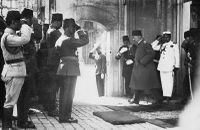
The Treaty of Sèvres was destined never to be ratified. Elections were held throughout Anatolia and with the participation of some parliamentarians, who had escaped from Constantinople, a new government was formed in Ankara. The rest of the story is the Turkish War of Independence.The Treaty of Lausanne made the new Turkish State internationally recognized. This new state gave the 'coup de grâce' to the Ottoman state, in 1922, with the overthrow of Sultan Mehmet VI Vahdettin by the new republican assembly of Turkey.
مسألة الخلافة
Besides the control of the physical lands, another question of importance was originated from the Ottoman Caliphate. The Ottoman Caliphs never claimed to be religious descendant of the Prophet but they were nonetheless an important authority figure within the Ottoman Empire. Muslims of India and of Anatolia supported and recognized the Ottoman caliphate for instance. As Sultans of the Empire, the Ottoman rulers had a very strong position, but the Sultan of Morocco, the Mahdists of the Egyptian Sudan, the Senussi in the Libyan Desert, the Wahabis in central Arabia, never acknowledged the title of Caliph as being higher than the Sultans' as the leader of state. Such recognition was also not given by the Arabs of the Hedjaz, Palestine, and Syria, which contain the holy places of Mecca, Medina, and Jerusalem.
The last official remnant of the empire—the title of caliphate—was constitutionally abolished on 3 March 1924. With the abolishment of the Ottoman Caliphate by the Grand National Assembly of Turkey, throughout the country from Makkah to Aleppo and from Sarejevo to Dhaka, the Ottoman Caliph's name was replaced in the Friday liturgy by that of Hussein bin Ali, Sharif of Mecca, the hereditary guardian of the holy cities of the Hedjaz, who briefly assumed the title of caliph.
انظر أيضاً
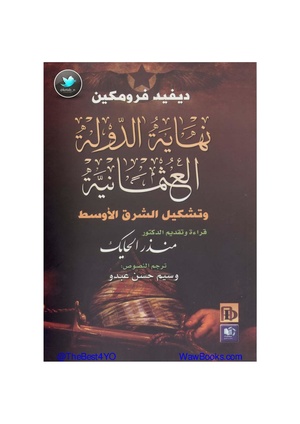
معرض الصور
المصادر
- ^ The Turkish Atrocities in Bulgaria, Letters of the Special Commissioner of the Daily News, J.A. MacGahan Esq. With an Introduction and Mr. Schuyler's Preliminary Report (London, 1876.)
- ^ The Encyclopædia Britannica, Vol.7, Edited by Hugh Chisholm, (1911), 3; Constantinople, the capital of the Turkish Empire...
- ^ Britannica, Istanbul:When the Republic of Turkey was founded in 1923, the capital was moved to Ankara, and Constantinople was officially renamed Istanbul in 1930.
- ^ Ion, Theodore P., "The Cretan Question", The American Journal of International Law, April 1910, pp. 276–284
- ^ Archives Diplomatiques, third series, vol. 126, p. 127.
- ^ أ ب Raymond Zickel and Walter R. Iwaskiw (1994). ""National Awakening and the Birth of Albania, 1876–1918", Albania: A Country Study". countrystudies.us. Retrieved 9 April 2008.
- ^ Notification of Neutrality
- ^ CUP Declaration of War, November 14
- ^ Tadeusz Swietochowski, Russian Azerbaijan 1905–1920, page 119.
- ^ Hovannisian. "Armenia's Road to Independence", pp. 288–289. ISBN 1-4039-6422-X.
- ^ Ezel Kural Shaw History of the Ottoman Empire and Modern Turkey. Page 326
- ^ أ ب Richard Hovannisian "The Armenian people from ancient to modern times" Pages 292–293
- ^ Mark Malkasian, Gha-Ra-Bagh": the emergence of the national democratic movement in Armenia page 22
- ^ Josh Belzman (23 April 2006). "PBS effort to bridge controversy creates more". MSNBC. Retrieved 5 October 2006.
- ^ Armenien und der Völkermord: Die Istanbuler Prozesse und die Türkische Nationalbewegung. Hamburg: Hamburger Edition. 1996. p. 185.
قراءات إضافية
- Lewis, Bernard (30 August 2001). The Emergence of Modern Turkey (3 ed.). Oxford University Press, USA. p. 568. ISBN 0-19-513460-5.
